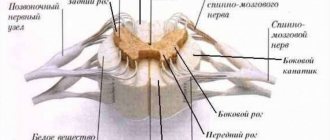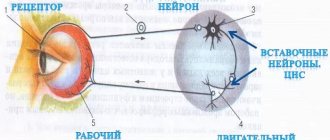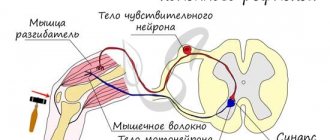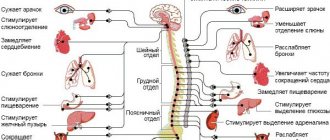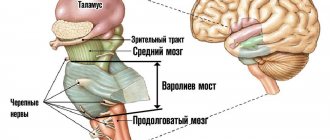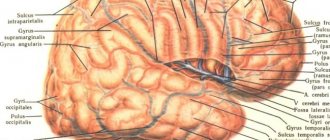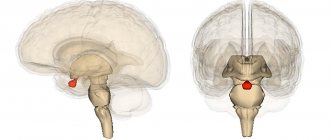The dendrite of a neuron (dendrum - branch) is a process of the neuron body through which it receives a signal from other cells. The dendrite receives a signal from the axon of another neuron or a receptor protein that responds to the environment.
Answering the question of what dendrites are, we can say that traditionally dendrites are considered as antennas of a neuron. Information exchange occurs in one direction: from axon to dendrite. The more dendrites a neuron has, the more information channels, the more complex decisions the neuron makes.
Synaptic cleft
You may be interested in: Semantic barriers and ways to eliminate them
The signal from other cells reaches the body of the neuron along one of its dendrites. The dendrite in the human nervous system usually receives a chemical signal (neurotransmitter) from the axon. The junction of a dendrite and an axon is called a synapse.
Synapses allow precise messages to be passed from neuron to neuron. Thanks to synapses, there is neuroplasticity and the ability to fine-tune the functions and behavior of the body.
The dendrite contains receptors that receive the neurotransmitter. Receptors are specialized proteins that capture a neurotransmitter molecule and, depending on their type, trigger further reactions in the cell.
Dendritic function
The functions of dendrites are to receive signals from other neurons, process these signals, and transmit information to the neuron's soma.
Get information
Dendrites resemble the branches of a tree in that they extend from the soma or cell body of the neuron and open into gradually smaller projections. At the end of these projections are synapses where information transfer occurs. More specifically, a synapse is where two neurons exchange signals: the upstream or presynaptic neuron releases neurotransmitters (usually at the end of the neuron, also called the axonal terminal), and the downstream or postsynaptic neuron detects them (usually into the dendrites). This figure shows the synapse of a presynaptic neuron (A) and a postsynaptic neuron (B):
At the synapse, the presynaptic neuron releases neurotransmitters (number 2 in the figure), which are molecules that the postsynaptic neuron detects. A postsynaptic neuron can detect neurotransmitters because it has neurotransmitter receptors (number 5 in the figure) to which neurotransmitters bind. If the postsynaptic neuron does not have a specific neurotransmitter receptor then the neurotransmitter will have no effect. Examples of neurotransmitters are dopamine, serotonin, norepinephrine, GABA and glutamate. If, for example, a presynaptic neuron releases dopamine, the postsynaptic neuron will require dopamine receptors to detect the signal and therefore receive information.
Some types of neurons have dendritic spines on their dendrites, which are small projections that protrude from the dendrites and have neurotransmitter receptors that increase the detection of neurotransmitters. You can find an example of a dendritic spine in this micrograph:
Process information
Once a neurotransmitter binds to a neurotransmitter receptor in a postsynaptic neuron, a signaling cascade begins that allows information to be processed at the synapse. This signaling cascade is neurotransmitter and neurotransmitter receptor dependent: there are excitatory neurotransmitters such as glutamate and inhibitory neurotransmitters such as GABA. Neurotransmitter receptors initiate a signaling cascade that activates specific ligand ion channels. Ligand-coupled ion channels allow ions to enter the neuron (e.g., Na+, Ca2+, Cl– or sodium, calcium, chloride, respectively) or exit the neuron (e.g., K+ or potassium). Let's see what happens in each case.
In the case of excitatory neurotransmitters, the presynaptic neuron releases the neurotransmitter, and the postsynaptic neuron detects it when it binds to its specific receptors. Because it is an excitatory neurotransmitter, binding to the receptor activates ligand-gated ion channels that allow positively charged ions to enter the cell: Na+ and Ca2+. At the same time, some K+ will also leave the cell. If enough positive charges enter the cell, the cell membrane potential increases, that is, there is a net influx of positive charges, then we call this the postsynaptic excitatory potential (EPSP), and the cell depolarizes. If there are enough positive charges such that the cell membrane potential reaches a threshold value, then an action potential exists (see below under Transport Information).
For inhibitory neurotransmitters, something similar happens, but instead of activating ligand-gated Na+ and Ca2+ channels, binding to the receptor will result in activation of ligand-gated Cl– channels. Here Cl– will flow into the postsynaptic neuron. In addition, K+ will leak out of the cell. Therefore, the net influx of negative charges (Cl–) results in a decrease in the cell membrane potential and hence what we call the postsynaptic inhibitory potential (IPSP). The cell is now hyperpolarized.
Transfer of information
The sum of many EPSPs may exceed the threshold required for the postsynaptic neuron to initiate an action potential. To understand this, we need to first understand some intrinsic properties of neurons.
The normal or physiological membrane potential of neurons at rest is about -65 mV. This means that the inside of the neuron is negatively charged relative to the outside of the cell. The reason for this is that inside the cell there are some positive charges (K+) as well as other negatively charged ions (A–), while outside the cell there are more positive ions (Na+ and Ca2+) and some negatively charged ones ( Cl-). The sum of all the charges makes the outside of the cell more positive and the inside of the cell more negative.
When EPSP occurs in dendrites, the membrane potential of the postsynaptic neuron increases, for example, from the physiological -65 mV to -64 mV, that is, it becomes less negative. When the sum of many EPSPs causes the neuron's membrane potential to reach a threshold value of about -55 mV, then the neuron fires an action potential, which transmits information to the soma and then along the axon to the end of the postsynaptic neuron. reaching at some point the end of the axon, where it releases neurotransmitters into the next neuron. Therefore, action potentials usually start from the dendrites and propagate along the neuron.
If the sum of many EPSPs does not reach the threshold required to trigger an action potential, then little happens and no signal is transmitted to the soma or axon. This graph illustrates what happens when the sum of EPSPs reaches and does not reach the threshold value (-55 mV) to trigger an action potential:
If there are many IPSPs, then more EPSPs are required to exceed the threshold membrane potential to generate an action potential.
Dendritic spines
Small growths called spines form on the dendrites. The latter can take many forms, but the most persistent is that of a fungus.
The number of dendritic spines ranges from 20 to 50 per 10 µm of dendrite length. The spines are very variable in shape and volume.
There are 86 billion neurons in the brain. Axons, dendrites and cell bodies of neurons form huge neural networks.
Dendrites are responsible for learning and memory, and also control the balance of the system. When there is a local strengthening of connections between certain neurons, it is in the dendrites that the production of a protein increases, regulating the decrease in the activity of other synapses.
What is a dendrite - functions and morphology
Dendrites are numerous thin tubular or round protrusions of the cell body (perikarya) of a nerve cell.
The term itself speaks of the extreme branching of these areas of neurons (from the Greek δένδρον (dendron) - tree). The surface structure of neurocytes can contain from zero to many dendrites. The axon is most often single. The surface of dendrites does not have a myelin sheath, unlike axon processes.
The cytoplasm contains the same cellular components as the nerve cell body itself:
- endoplasmic granular reticulum;
- accumulations of ribosomes - polysomes (protein-synthesizing organelles);
- mitochondria (energy “stations” of the cell, which, using glucose and oxygen, synthesize the necessary high-energy molecules);
- Golgi apparatus (responsible for the delivery of internal secretions to the outer layer of the cell);
- neurotubules (microtubules) and neurofilaments are the main components of the cytoplasm, thin supporting structures that ensure the preservation of a certain shape.
The structure of dendritic endings is directly related to their physiological functions - receiving information from axons, dendrites, and perikarya of neighboring nerve cells through numerous interneuron contacts based on selective sensitivity to certain signals.
Training and Spikes
Dendritic spines are responsible for the possibility of learning and memory formation. Thanks to the spines and their plasticity, a neuron can easily connect to one or another neighbor and quickly disconnect from them, controlling the possibility of receiving a signal.
It would be logical to assume that if synaptic connections are responsible for memories, then their plasticity is a problem for maintaining memories of the past. In 2009, Nature published a publication in which the authors examined how learning experience affects synaptic connections in mice.
The work showed that a large number of new spines formed from a new experience disappeared over time if the experience was not repeated periodically. But those that were preserved were most likely responsible for the acquired skills.
Moreover, if the training was repeated for a long time, spines were removed; apparently, the removed spines were responsible for incorrect actions. Learning and daily sensory experience leave permanent marks in the form of a small group of spines formed at different stages of learning.
What are dendrites if not a huge library of memories? But the main problem of dendritic spines is that they are very sensitive to any mechanical and chemical influences. Therefore, brain injuries, even if localized in one place, usually affect the entire neural network.
Conduction of nerve impulses
The receptor membrane of the surface of the dendrites (as well as the body of the nerve cell) is covered with numerous synaptic plaques that transmit excitation to the receptive area of the surface membrane of the neuron, where a bioelectric potential is generated.
Information encoded in the form of electrical impulses is transmitted to the electrically excitable conductive membrane of the axon. In this way, the body's neural networks are formed.
Sleep and learning
A 2014 study by ZG Yang showed how, after 24 hours of training and sleep, new dendritic spines appeared in mice and some of the existing ones disappeared. The authors note that the rate of formation of new spines in mice trained to learn a new behavior was significantly higher within 6 hours of training compared to untrained mice.
In addition, the authors showed that spines form much more slowly when mice are deprived of sleep. And neither new skill training nor late sleep can correct the situation.
What is affected by the branching of nerve processes?
The neuron body is a universal transmitting and simultaneously receiving biological object. The volume (primarily of incoming information) is directly proportional to the number of incoming nerve impulses. They are determined by the degree of branching of the dendritic tree. Therefore, dendrites are structures of a neurocyte that play an integrative function.
Moreover, the processes expand the area of contact between nerve cells. The additional formation of synapses greatly increases the efficiency of all parts, both the brain and spinal cord, and the nervous system as a whole.
Dendrite as an independent unit
What dendrites are is still being figured out. The fact is that it is difficult to study the behavior and functions of dendrites in living objects.
If the size of a neuron is about ten microns, then the length of a dendrite can reach up to a thousand. Dendrites are usually understood as not very active participants in the process.
In 2021, a study was published in the journal Science that reconsiders the classic view of dendrites. It turned out that dendrites generate signals several times more often than the neuron body does, which suggests that information is encoded at the dendritic level as well.
It was previously discovered that if during an experience the cell bodies of neurons were activated and the dendrites were silent, then long-term memory was not formed regarding this experience. It was suggested that the activity of neurons is associated more with real time, with current experiences, and dendrites - with what will remain in memory.
What are dendrites, given the new data? These are amazing structures that make up 90% of the nervous tissue and perhaps take on most of the work of storing and transforming experience.
Dendritic malfunction
Dendrites play a very important role in transmitting information between neurons. Thus, it is not surprising that dendritic malfunctions are associated with various disorders of the nervous system. Malfunctions vary in type and severity and range from abnormal morphology to abnormal dendritic branching, abnormalities in dendritic development, and abnormal loss of dendritic branching and dendritic genesis. All this is associated with disorders such as schizophrenia, autism, depression, anxiety, Alzheimer's disease and Down syndrome and others.
Long axon process
As mentioned above, the axon, body and dendrites are the main parts of a neuron. An adult nerve cell always has one axon. As a rule, it starts from the soma, but in some cases it can grow from one of the dendrites. The axon has a cone shape, that is, it gradually narrows towards its end. Along the entire process there are constrictions called nodes of Ranvier. Inside the process there is cytoplasm, which has a set of organelles different from the soma.
Speaking about axon length, it should be noted that most neurons have processes only a few millimeters long, however, spinal cord axons can reach a meter in length. Its main function is the transmission of nerve impulses, which it performs at a speed of more than 27 m/s.
How information enters a nerve cell
In the process of transfer of electrical charges, which underlies excitation and inhibition, along with the axon, dendrites also participate. These are neuron processes that form synapses with the branches of the dendritic tree of other neurocytes. It has been experimentally established that dendrites are outgrowths of the cell cytoplasm covered with a membrane. It produces weak electrical impulses - action potentials.
Thanks to the system of short processes, one nerve cell receives and transmits several thousand such impulses generated by synapses. This is not the only function of dendrites. They also process and integrate information entering the neurons, which ensures the regulation and control exercised by the nervous system over all organs and tissues of the human body.
What is a neuron? Definition
Before moving on to the answer to the question: “What is a dendrite?”, it is necessary to take a closer look at the nerve cell of which it is a part.
A neuron is a cell, the totality of which forms the nervous system. Its main functions are to receive, process and transmit information through chemical and electrical signals, thanks to the specific sensitivity of its plasma membrane. Neurons receive and transmit electrical impulses among themselves through a special connection called a synapse. In addition, they transmit a signal to other cells, for example, muscle cells, which activates the latter, forcing them to contract. A feature of neuronal cells is that most of them, having reached a mature state, do not divide.
What is included in a neuron? The axon and dendrite are its main components. A neuron is a typical central cell body called a soma. Several short processes of the soma are dendrites responsible for receiving electrical excitations, and one long process of the soma is called an axon; it is responsible for transmitting the received impulse to other cells.
Nervous system
Each neuron connects via an axon to about 1,000 other neurons, and can receive information via its dendrites from 10,000 neurons. These properties of nerve cells organize them into a huge nervous network or system. According to general estimates, the adult brain contains about 1014 synaptic connections, and in a child this number is several (5-10) times higher. With age, the number of synaptic connections decreases and becomes constant when a person reaches adulthood.
Thanks to the organization of neurons into a network, the ability to perceive external signals, think and control the behavior of all parts of the body and body systems appears.
